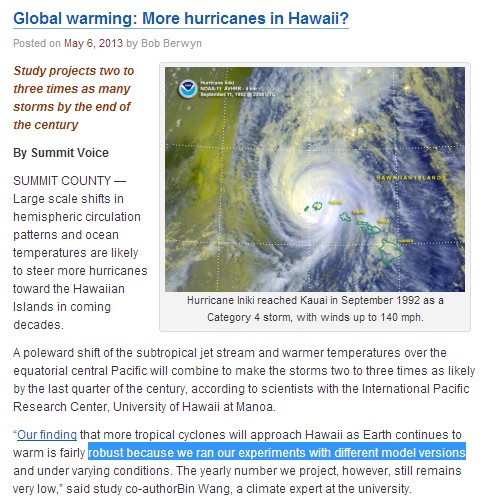“Our finding that more tropical cyclones will approach Hawaii as Earth continues to warm is fairly robust because we ran our experiments with different model versions and under varying conditions.
Climate models can’t even forecast ENSO, much less hurricanes. The only thing that is robust is the exceptional dissonance of climate scientists slopping at the massive federal funding trough.
Global warming: More hurricanes in Hawaii? | Summit County Citizens Voice



GIGO is the basis for CACA that is repeated by the CLB!
Payment by result should solve some of these problems.
The world isn’t getting any warmer. Berwyn seems to be unaware there has not been any statistically significant warming in the last 17 – 23 years, depending on the data set used (HadCRUT 3, HadCRUT 4, RSS, UAH or GISS). Nor is it very likely to warm any time soon, with the PDO in the cold mode, the AMO to switch to its negative (cold) mode within a decade, and solar activity at its lowest level in more than 100 years. So where is all the warmth in the East Pacific going to come from? Apparently, only from the faulty models Berwyn is using
Warmist scientists like Berwyn seem to confuse climate modeling with real science. The models, which are tuned (i.e. manipulated) to create pre-ordained CO2-induced warming, have been wrong about everything.
Werner Brozekhttp://wattsupwiththat.com/2013/03/05/has-global-warming-stalled-now-includes-january-data/
For RSS the warming is not significant for over 23 years.
For RSS: +0.127 +/-0.134 C/decade at the two sigma level from 1990
For UAH the warming is not significant for over 19 years.
For UAH: 0.146 +/- 0.170 C/decade at the two sigma level from 1994
For Hadcrut3 the warming is not significant for over 19 years.
For Hadcrut3: 0.095 +/- 0.115 C/decade at the two sigma level from 1994
For Hadcrut4 the warming is not significant for over 18 years.
For Hadcrut4: 0.095 +/- 0.110 C/decade at the two sigma level from 1995
For GISS the warming is not significant for over 17 years.
For GISS: 0.111 +/- 0.122 C/decade at the two sigma level from 1996
Kirk, using logic and rational thought doesn’t work with a bedwetter.
Climate ‘modeling’ reminds me of Progressive Lakota Logic… 12 is my favorite, and applies here perfectly…
“Dakota Indian tribal wisdom
Dakota Indian tribal wisdom says that “when you discover you are riding a dead horse… The best strategy is to dismount.” However… In the education world… We NEVER seem to get it…!!! Smarter Strategies —(i.e. What’s wrong with Education in America?)
1. Buy a bigger and stronger whip.
2. Changing riders.
3. We are not stupid… “There is obviously a better way to ride this horse…”
4. Appoint a committee to study the horse.
5. Arrange to visit other schools, to see how they ride dead horses.
6. Increase the standards required for riding dead horses.
7. Appoint a special team to revive the dead horse.
8. Create a training session to increase our dead horse riding ability.
9. Study the “state of dead horses” in today’s environment.
10. Change the requirements… declaring that “This horse is not dead.”
11. Hire more Administrators to repair the dead horse.
12. Harness several dead horses together, for increased speed.
13. Declare that “No horse is too dead to beat.”
14. Provide additional funding to increase the dead horse’s performance.
15. Do a CA Study to see if outside contractors can ride it cheaper.
16. Purchase a product to make dead horses run faster.
17. Declare the horse is… “better, faster, and cheaper,” when dead.
18. Form a quality circle to find other uses for dead horses.
19. Re-analyze the performance requirements for all dead horses. — And Finally —
20. As a Last Resort… Promote the dead horse… To a Superintendent’s Position…”
Where did you get this wonderful list?
I’ve had that for about 20 years now, there are several versions on the interwebs, and they all remind me of life experiences.
What is old is new again.
Thanks, I will be borrowing it.
Are Dakota and Lakota the same?
I’ve often wondered.
Yes and no.
“The Sioux (pron.: /?su?/) are Native American and First Nations people in North America. The term can refer to any ethnic group within the Great Sioux Nation or any of the nation’s many language dialects. The Sioux comprise three major divisions based on Siouan dialect and subculture: Isá?yathi or Isá?athi (“Knife,” originating from the name of a lake in present-day Minnesota). Residing in the extreme east of the Dakotas, Minnesota and northern Iowa, and are often referred to as the Santee or Eastern Dakota; Ihá?kt?u?wa? and Ihá?kt?u?wa?na (“Village-at-the-end” and “little village-at-the-end”). Residing in the Minnesota River area, they are considered to be the middle Sioux, and are often referred to as the Yankton and the Yanktonai, or, collectively, as the Wi?híyena (endonym) or the Western Dakota (and have been erroneously classified as “Nakota”[2]). Thít?u?wa? or Teton (uncertain, perhaps “Dwellers on the Prairie”; this name is archaic among the natives, who prefer to call themselves Lak?óta[3]). The westernmost Sioux, known for their hunting and warrior culture, are often referred to as the Lakota.”
http://en.wikipedia.org/wiki/Sioux
So where does the word “Dakota” come from? Is it an Indian name?
Good question. It appears to be a Lakota word for ‘friend’, and was applied in many fashions to many people. I would guess that when whitey met the Lakota, the indigenous pointed at themselves and said ‘dakota’. Or the chief was a hairlip, or something…
Poor old Bob will either die of a heart attack or end up a quivering wreck in the loony bin. He worries far too much about things, that he can’t even do anything about anyway.
Take a tip, Bob. Get out, enjoy life and accept nature for what it is.
Bob is getting a good dose of the “thing of the past” today.